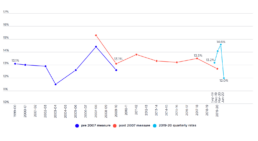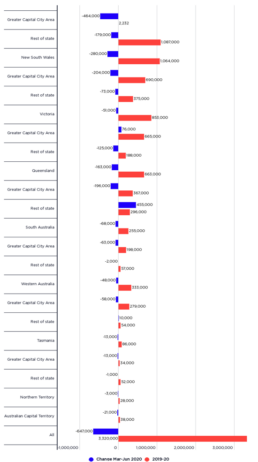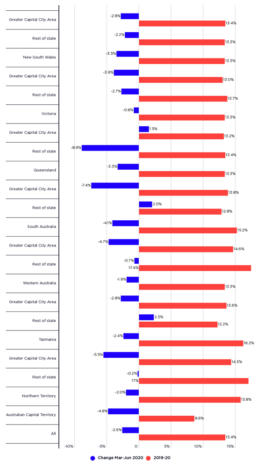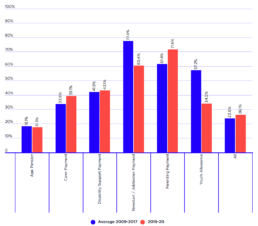Community attitudes: Incomes of those on the lowest incomes are too low and should be increased
This chart shows the responses in our Community attitudes towards poverty and inequality survey 2023 to the query whether the incomes of those in the lowest income group are too low and should be increased. It shows that 76% of people in Australia agreed that the incomes of those on the lowest incomes are too low and should be increased. Read the full report here: https://bit.ly/communityattitudes2023
Community attitudes: The gap between the wealthy and those in poverty is too great and should be reduced
This chart shows the responses in our Community attitudes towards poverty and inequality survey 2023 to the idea that The gap between rich and poor is too great and should be reduced. It shows that 74% of people agreed that the gap between the wealthy and those living in poverty is too great and should be reduced. Read the full report here: https://bit.ly/communityattitudes2023
Community attitudes: Poverty is a problem that can be solved
This chart shows the responses in our Community attitudes towards poverty and inequality survey 2023 to the idea that Poverty is a problem that can be solved. It shows that 75% of people in Australia agreed that poverty is a problem that can be solved with the right systems and policies. Read the full report here: https://bit.ly/communityattitudes2023
Community attitudes: Government policies have caused some people to experience poverty
This chart shows the responses in our Community attitudes towards poverty and inequality survey 2023 to the statement Government policies have caused some people to be poor It shows that 62% of people in Australia agreed that government policies have caused some people in Australia to experience poverty. Read the full report here: https://bit.ly/communityattitudes2023
Most people support lifting incomes for those with the least
Three-quarters of people in Australia support an income boost for people with the least while less than a quarter think it’s possible to live on the current JobSeeker rate, new research by ACOSS and UNSW Sydney shows. The latest report from the Poverty and Inequality partnership, Community attitudes towards poverty and inequality 2023: Snapshot report, also shows 74% think the gap between wealthy people and those living in poverty is too large and should be reduced. The survey of 2,000 adults in Australia shows most people (62%) think government policies have contributed to poverty, while 75% think it can be solved with the right systems and policies. More than two-thirds (69%) think poverty is a big problem in Australia Just 23% agreed they could live on the current JobSeeker rate Another 58% said they would not be able to live on that amount, while 19% were unsure Three-quarters (76%) agree the incomes of people earning the least are too low and should be increased Most people…
Comparison of poverty trend and SDG target path
This chart shows the percentage of people in poverty between 1999-20 to 2019-20 and compares this with the percentage of people in poverty if we were following the target set out in the UN Sustainable Development Goals, of which Australia is a signatory. The Sustainable Development Goal on poverty includes: "By 2030, reduce at least by half the proportion of men, women and children of all ages living in poverty in all its dimensions according to national definitions" (note that this chart uses 50% of median income in lieu of an accepted national definition of poverty in Australia).
Number of people in poverty by location in 2019-20, and change in poverty
Poverty was somewhat higher (at 2,232,000 people) among people living in capital cities than among those living outside them (1,087,000 people). Poverty rates were highest in non-urban areas in the smallest States and Territories, including 52,000 people outside the capital in Tasmania, 57,000 people outside the capital in South Australia, and 28,000 people in the Northern Territory. The greatest reductions in poverty in the fourth quarter of 2019-20 occurred outside the capital in Victoria (by 125,000 people), in Brisbane (by 196,000 people), in Hobart (by 13,000 people), and in the Australian Capital Territory (by 21,000 people).
Rate of poverty by location in 2019-20, and change in poverty
Poverty was somewhat higher (at 13.4%) among people living in capital cities than among those living outside them (13.3%). Two thirds (67%) of people in poverty lived in capital cities, which is broadly equivalent to the population share living in those cities. Poverty rates were highest in non-urban areas in the smallest States and Territories, including 17.7% outside the capital in Tasmania, 17.4% outside the capital in South Australia, and 15.8% in the Northern Territory. The greatest reductions in poverty in the fourth quarter of 2019-20 occurred outside the capital in Victoria (by 8.9%), in Brisbane (by 7.4%), in Hobart (by 5.5%), and in the Australian Capital Territory (by 4.8%).
New report highlights depth of poverty for people on income support
People who are unemployed, people receiving income support, renters, sole parents, women, children and people with disability are at highest risk of poverty, while those on Youth Allowance experience deepest poverty, according to Poverty in Australia 2023: Who is affected, released today by the Poverty and Inequality Partnership led by ACOSS and UNSW Sydney. The depth of poverty experienced by people on income support payments is severe. Households relying on Youth Allowance are in the deepest poverty, with incomes on average $390 per week below the poverty line. People in households relying on JobSeeker were $269 per week below the poverty line, and people in households relying on parenting payment were $246 per week below the poverty line. By payment type, 60% of people receiving JobSeeker Payment and 72% of people receiving Parenting Payment live in poverty, compared with one in eight (13%) people and one in six children (17%) in poverty overall, based on the latest available data…
Poverty in income support households (2019-20 compared with previous years - % of people)
Poverty was higher overall in 2019-20 in ‘income support households’, with large increases for those reliant on Parenting Payment and Carer Payment, but much lower in those relying mainly on JobSeeker Payment and Youth Allowance.







